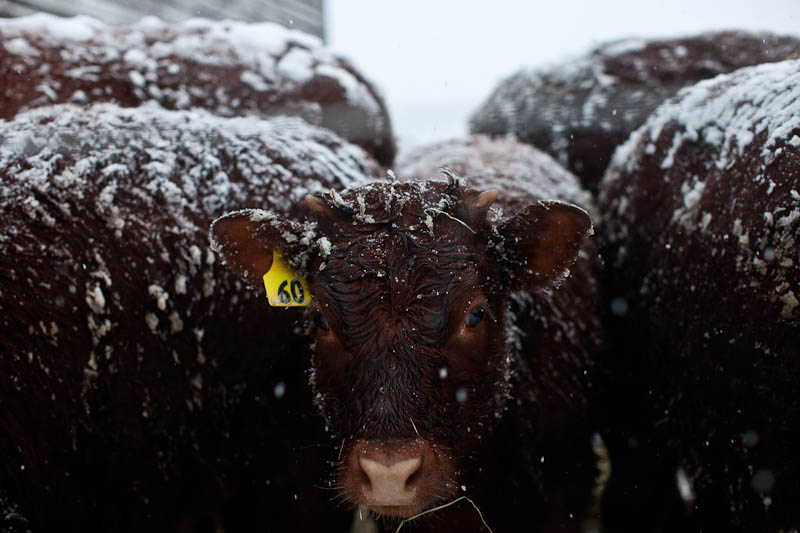Grass Farmer
 This week: overnight lows of 7 degrees; daytime highs barely past freezing. This is prime weather for sitting in a warm room and thinking about our biggest crop—one that’s already in the ground and percolating under 5 inches of snow:Grass.You may think “rancher” when you drive by a field of cattle, but what you are really driving by is a grass farm. Come spring, when pastures break out in a lime-green five o’clock shadow, all animal-management orbits around strategic grazing schedules: they need to eat, but the grass needs to grow. Once summer comes, and the animals can’t eat the stuff fast enough, we can relax and let the cows, sheep and the chickens do the rest.We can relax, that is, if we don’t give a fig about the environment or food-chain consequences.If meat (pounds on the hoof) is your metric, you forget the grass and bring on the corn. You ignore the fact that ruminants (cows, sheep, goats) are designed to live entirely on grass, and you let cattle imitate the 97% of their fellow animals in this country by living entirely on grain.Corn for breakfast, lunch, and dinner—plus a regiment of growth hormones—and you have slaughter-ready cattle in 15 months, which is a full 9 months sooner than their pokey grass-eating counterparts. Abundant, cheap meat flows to supermarkets year round, and the humans in charge make more money.This means it is time to quote Wendell Berry: “What's wrong with us generates more GNP than what is right with us.” What follows is a learned unpacking of the three critical variables (animal, environment, consumer) packed into Berry’s simple truth.
This week: overnight lows of 7 degrees; daytime highs barely past freezing. This is prime weather for sitting in a warm room and thinking about our biggest crop—one that’s already in the ground and percolating under 5 inches of snow:Grass.You may think “rancher” when you drive by a field of cattle, but what you are really driving by is a grass farm. Come spring, when pastures break out in a lime-green five o’clock shadow, all animal-management orbits around strategic grazing schedules: they need to eat, but the grass needs to grow. Once summer comes, and the animals can’t eat the stuff fast enough, we can relax and let the cows, sheep and the chickens do the rest.We can relax, that is, if we don’t give a fig about the environment or food-chain consequences.If meat (pounds on the hoof) is your metric, you forget the grass and bring on the corn. You ignore the fact that ruminants (cows, sheep, goats) are designed to live entirely on grass, and you let cattle imitate the 97% of their fellow animals in this country by living entirely on grain.Corn for breakfast, lunch, and dinner—plus a regiment of growth hormones—and you have slaughter-ready cattle in 15 months, which is a full 9 months sooner than their pokey grass-eating counterparts. Abundant, cheap meat flows to supermarkets year round, and the humans in charge make more money.This means it is time to quote Wendell Berry: “What's wrong with us generates more GNP than what is right with us.” What follows is a learned unpacking of the three critical variables (animal, environment, consumer) packed into Berry’s simple truth. Cows: When they live on grain, their blood and urine gets acidic, their rumens get inflamed, and if you look at them crosswise, they bloat up and die. So, the producer adds antibiotics to the daily chemical regime and ignores phenomena like antibiotic-resistant bacteria and the need for ever larger doses of antibiotics.The so-called “Environment”: The word ‘environment’ sounds too much like pastures and streams, and where these animals live is anything but. In case the name “Concentrated Animal Feeding Operations” or CAFO’s, doesn’t sound creepy enough, google it, and you will have nightmares for weeks. If you’ve never seen a CAFO, this is by design since these meat factories are hidden away where they can create waste-management and ground-water issues relatively unobserved. Add to this the need for heavy applications of pesticides and synthetic fertilizers (derived from petroleum) to get the soil to push out enough grain to feed all those ‘concentrated’ animals, and you have to put heavy quotes around the word “environment.”The Consumer: Yep. That’s you, me, and all our neighbors. But instead of dunning the human race for what appear to be egregiously stupid choices, let’s look at what is lost and gained by sticking to the CAFO model:
Cows: When they live on grain, their blood and urine gets acidic, their rumens get inflamed, and if you look at them crosswise, they bloat up and die. So, the producer adds antibiotics to the daily chemical regime and ignores phenomena like antibiotic-resistant bacteria and the need for ever larger doses of antibiotics.The so-called “Environment”: The word ‘environment’ sounds too much like pastures and streams, and where these animals live is anything but. In case the name “Concentrated Animal Feeding Operations” or CAFO’s, doesn’t sound creepy enough, google it, and you will have nightmares for weeks. If you’ve never seen a CAFO, this is by design since these meat factories are hidden away where they can create waste-management and ground-water issues relatively unobserved. Add to this the need for heavy applications of pesticides and synthetic fertilizers (derived from petroleum) to get the soil to push out enough grain to feed all those ‘concentrated’ animals, and you have to put heavy quotes around the word “environment.”The Consumer: Yep. That’s you, me, and all our neighbors. But instead of dunning the human race for what appear to be egregiously stupid choices, let’s look at what is lost and gained by sticking to the CAFO model:
- Lost: The meat you eat has more overall fat and fewer “good fats” and Omega-3s, such that 6 ounces of grain-produced tenderloin loads you up with 92 more calories than the same 6 ounces of grass-produced beef. And, if you are a typical American and eat 67 pounds of beef per year, you take on 16,642 extra calories and actually lose nutritional benefit.
- Gained: $300/year more in your family budget
 Why grass-produced beef costs $10/pound was analyzed for us in our cattle-management class by a local “grass farmer” named Olivie who traced for us the career of one animal from calf to burger as follows:1 calf of ~500lb at $1.50/ lb = $750Vet visits: $50
Why grass-produced beef costs $10/pound was analyzed for us in our cattle-management class by a local “grass farmer” named Olivie who traced for us the career of one animal from calf to burger as follows:1 calf of ~500lb at $1.50/ lb = $750Vet visits: $50
- (This assumes perfect health but allows for the cost of castrating a steer)
Kelp, minerals and salt lick for 2 seasons: $50Hay: $450
- 1 Animal Unit (1000 pounds) eats 20 lbs of hay/day. In the Northeast we need to feed hay for 180 days during winter when our pastures are dormant. A grass-fed cow requires 2 growing seasons to reach slaughter weight. A bale of hay is $5. If you can grow your own and have fertile soil, you can get about 150 bales per acre, which works out to needing 1 acre per animal. Of course you also need land, hay-baling equipment, etc.
Bedding: $364
- 1 bale a week for the 26 weeks your animal is without pasture and needs a feces-free place to lay down and chew its cud (particularly important for pregnant cows). Straw costs $7/bale, which you’ll need for two winters.
Slaughter, cut, package, and label: $450Total Expenses: $2,114Total revenue: $3,300 –from the 330 pounds of boxed-up meat you will typically getNet Profit: $1,136 – for two years of work, excluding land, labor (moving pasture, water, feeding, chain harrowing), infrastructure improvements, marketing or delivery costs.The conclusions you could draw from this vary and may include the observation that “grass farmers” are highly motivated and energetic idiots—especially when you consider the marketing challenge of asking your customers to pay $10/pound when she can go to MegaMart on Super Tuesday and get meat that looks the same for $3/pound.
